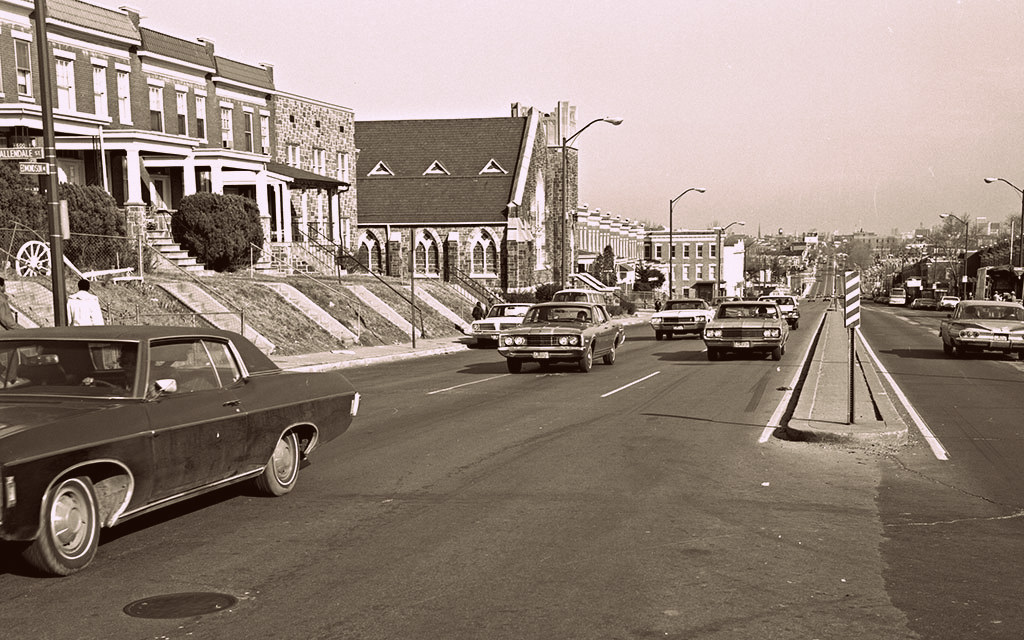Explore stories of scenic parkways, classic movie houses, and, of course, the life-long home of Mayor William Donald Schaefer.
 Where Edmondson Avenue crosses the Gwynns Falls, quiet blocks of streetcar suburbs give way to landmarks from a new era of Baltimore history. From drivers on Hilton Parkway to children at the modernist Mary Rodman Recreation Center, visitors and residents can appreciate Allendale’s history of architecture and activism.
Where Edmondson Avenue crosses the Gwynns Falls, quiet blocks of streetcar suburbs give way to landmarks from a new era of Baltimore history. From drivers on Hilton Parkway to children at the modernist Mary Rodman Recreation Center, visitors and residents can appreciate Allendale’s history of architecture and activism.
Hilton Parkway
More than just a road, Hilton Parkway followed a visionary plan for the city by landscape architect Frederick Law Olmsted, Jr. Neighborhoods along Edmondson Avenue and the northwestern suburbs near Walbrook Junction grew in the 1920s, but the stream of the Gwynns Falls blocked traffic between the two. In 1926, the Olmsted Brothers published a report recommending the development of stream valley parkways. The vision came true when New Deal funds in the 1930s paid for the construction of Hilton Parkway through the Gwynns Falls Valley, including two bridges—the largest spanning 390 feet with 90-foot wide arches.
William Donald Schaefer Residence
Born on November 2, 1921, William Donald Schaefer lived most of his life in a modest rowhouse at 620 Edgewood Street. The only child of William Henry and Tululu Irene Schaefer, he attended Lyndhurst Elementary School, Baltimore City College and the University of Baltimore.
After serving in Europe during WWII, Schaefer made two unsuccessful attempts for a seat in the Maryland House of Representatives. In 1955, local political king-maker Irvin Kovens, nicknamed the “The Furniture Man” for his West Baltimore furniture store, and Phillip H. Goodman, founder of the Dandy Fifth Democratic Club, recruited Schaefer to run for the Fifth District Baltimore City Council seat. From this modest beginning, Schaefer went on to become Baltimore City Council President, then Mayor, and Governor of Maryland.
“The greatest thing that’s happened to me is being able to walk along streets and people say, ‘Hi, Mayor. Hi, Don. Hi, Schaefer.’ … They don’t think I’m anything at all, except one of them.”
William Donald Schaefer on his political career in Baltimore, January 21, 1987
Mount Olivet Baptist Church
Mount Olivet Baptist Church, established in 1922, has occupied the former Edgewood Theater on Edmondson Avenue since the late 1960s. Built in 1930, the theater was designed by John J. Zink and boasted a tall electric sign that made the building a near twin of the Patterson Theater on Eastern Avenue. In 1962, the theater enjoyed a brief second life as an “art house.” Soon after the theater closed, Bishop Wilburn S. Watson and the Mount Olivet Baptist congregation moved from Riggs Avenue to the new church in the old movie house.
Mary E. Rodman Elementary School & Recreation Center
Named after Mary E. Rodman, this modern school and recreation center honor the legacy a little-known local leader in education for African Americans. In 1889, Rodman graduated in the first class of Baltimore’s first public high school for African Americans. She taught at black schools around the city for nearly fifty years and advocated for black educators and administrators up until her death in 1937. Built in 1962, the school on Mulberry Street that took her name immediately filled to capacity as many African American families moved to the area in the early 1960s. The recreation center, designed by the nationally prominent black architect Louis Fry, Jr., was built in 1974.
Lyndhurst Elementary School
Hundreds of people (including residents, local pastors, and even former Baltimore Mayor J. Barry Mahool) gathered on Collins Street in March 1926 to see Mayor Howard Jackson lay the cornerstone for a new school. The ceremony was a hard fought victory for local families and the Lyndhurst Improvement Association. Local citizens united again in the late 1970s to call for the rehabilitation of the deteriorated 50-year-old building. Graduates of the school include Congressman Elijah Cummings and his six siblings who all grew up across the street.
St. Bernadine’s Roman Catholic Church
In the early 1900s, many first, second or third generation Irish Catholic immigrants moved west and bought new homes built by developer James Keelty in Allendale and Edmondson Village. After Keelty’s six-year-old daughter Nora Bernardine died in 1922, he decided to build a new church for his neighbors and donated the building to the Baltimore Archdiocese. Completed in 1929, the church was designed by architect Francis E. Tormey (who also designed the Furst Memorial Chapel at Most Holy Redeemer Cemetery). The Archdiocese dedicated the building as a memorial to young Nora.

